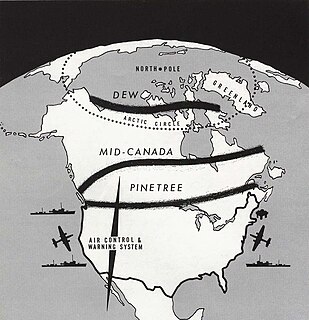 W
WAustrian air defence is the air defense system that protects the nation of Austria. It integrates civilian and military radar systems under the authority of the Austrian Air Force.
 W
WThe RCA 474L Ballistic Missile Early Warning System was a United States Air Force Cold War early warning radar, computer, and communications system, for ballistic missile detection. The network of twelve radars, which was constructed beginning in 1958 and became operational in 1961, was built to detect a "mass ballistic missile attack launched on northern approaches [for] 15 to 25 minutes' warning time" also provided Project Space Track satellite data.
 W
WChain Home, or CH for short, was the codename for the ring of coastal Early Warning radar stations built by the Royal Air Force (RAF) before and during the Second World War to detect and track aircraft. Initially known as RDF, and given the official name Air Ministry Experimental Station Type 1 in 1940, the radar units themselves were also known as Chain Home for most of their life. Chain Home was the first early warning radar network in the world, and the first military radar system to reach operational status. Its effect on the outcome of the war made it one of the most powerful weapons of what is today known as the "Wizard War".
 W
WThe Distant Early Warning Line, also known as the DEW Line or Early Warning Line, was a system of radar stations in the far northern Arctic region of Canada, with additional stations along the North Coast and Aleutian Islands of Alaska, in addition to the Faroe Islands, Greenland, and Iceland. It was set up to detect incoming Soviet bombers during the Cold War, and provide early warning of any sea-and-land invasion.
 W
WThe Dowding system was the world's first wide-area ground-controlled interception network, controlling the airspace across the United Kingdom from northern Scotland to the southern coast of England. It used a widespread dedicated land-line telephone network to rapidly collect information from Chain Home (CH) radar stations and the Royal Observer Corps (ROC) in order to build a single image of the entire UK airspace and then direct defensive interceptor aircraft and anti-aircraft artillery against enemy targets. The system was built by the Royal Air Force just before the start of World War II, and proved decisive in the Battle of Britain.
 W
WThe Mid-Canada Line (MCL), also known as the McGill Fence, was a line of radar stations running east–west across the middle of Canada, used to provide early warning of a Soviet bomber attack on North America. It was built to supplement the less-advanced Pinetree Line, which was located further south. The majority of Mid-Canada Line stations were used only briefly from the late 1950s to the mid-1960s, as the attack threat changed from bombers to ICBMs. As the MCL was closed down, the early warning role passed almost entirely to the more capable DEW Line further north.
 W
WThe NATO Integrated Air Defense System is a command and control network combining radars and other facilities spread throughout the NATO alliance's air defence forces. It formed in the mid-1950s and became operational in 1962 as NADGE. It has been constantly upgraded since its formation, notably with the integration of Airborne Early Warning aircraft in the 1970s. The United Kingdom maintained its own network, but was fully integrated with the network since the introduction of the Linesman/Mediator network in the 1970s. Similarly, the German network maintained an independent nature through GEADGE.
 W
WThe Pinetree Line was a series of radar stations located across the northern United States and southern Canada at about the 50th parallel north, along with a number of other stations located on the Atlantic and Pacific coasts. Run by North American Aerospace Defense Command (NORAD), over half were manned by United States Air Force personnel with the balance operated by the Royal Canadian Air Force. The line was the first coordinated system for early detection of a Soviet bomber attack on North America, but before the early 1950s radar technology quickly became outdated and the line was in full operation only for a short time.
 W
WROTOR was an elaborate air defence radar system built by the British Government in the early 1950s to counter possible attack by Soviet bombers. In order to get it operational as quickly as possible, it was initially made up primarily of WWII-era systems, notably the original Chain Home radars for the early warning role, and the AMES Type 7 for plotting and interception control. The system had a network of control stations, mostly built underground, and connected with an extensive telephone and telex network.